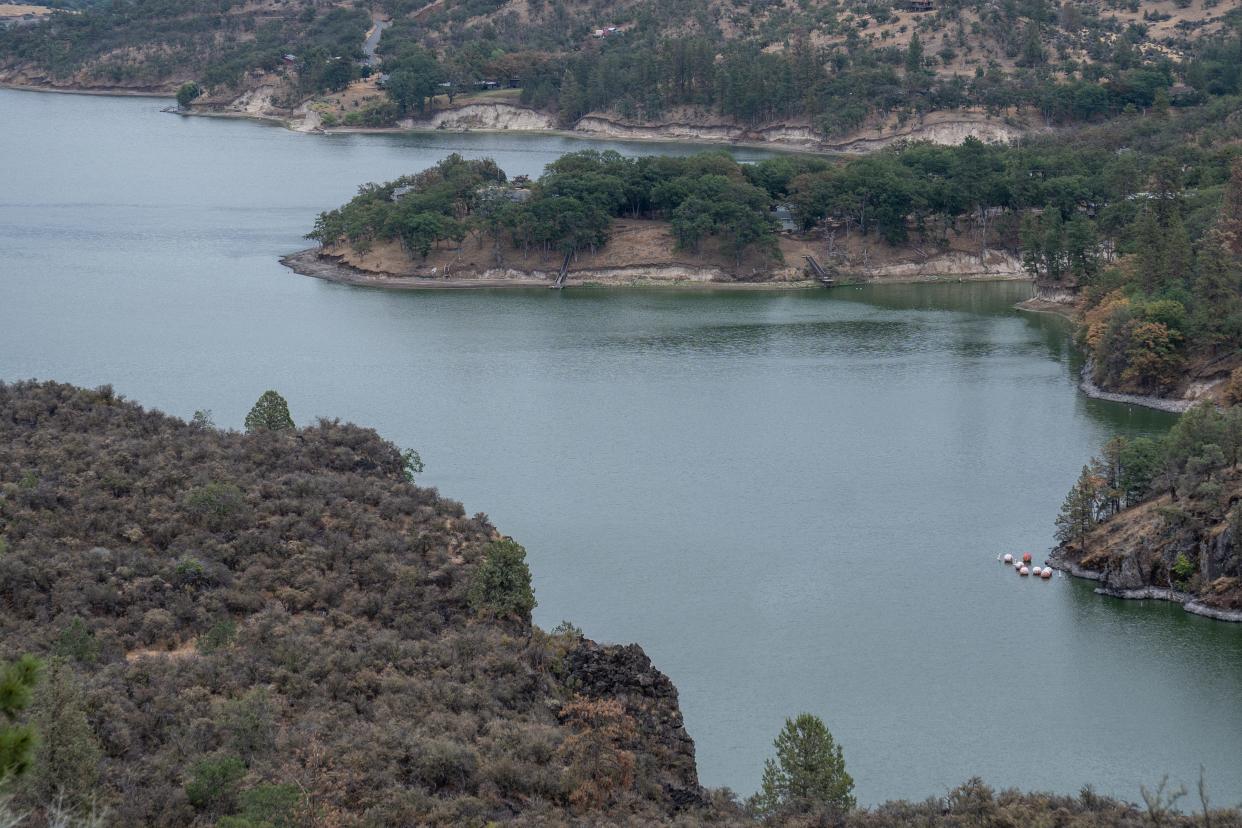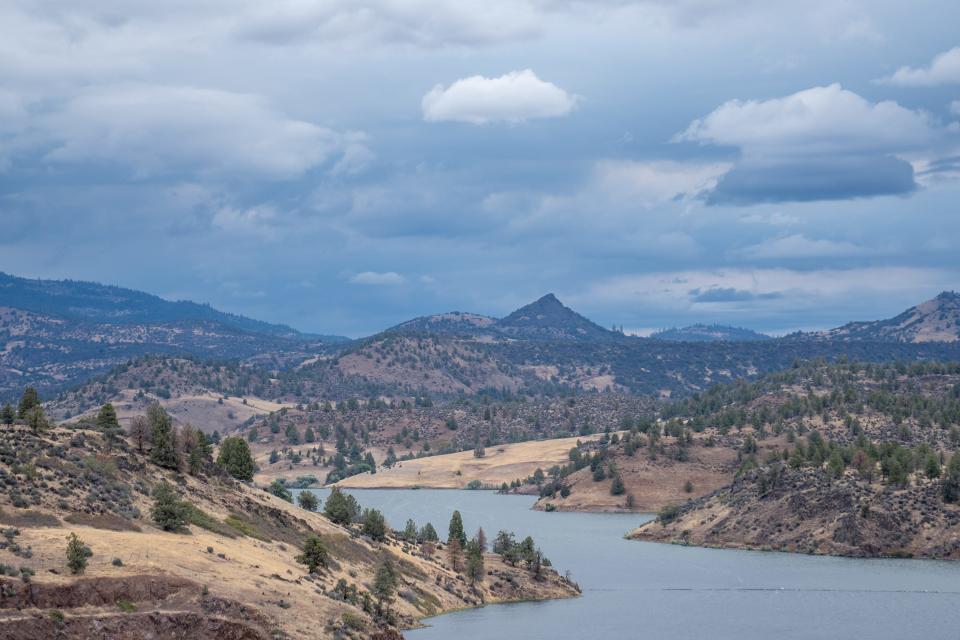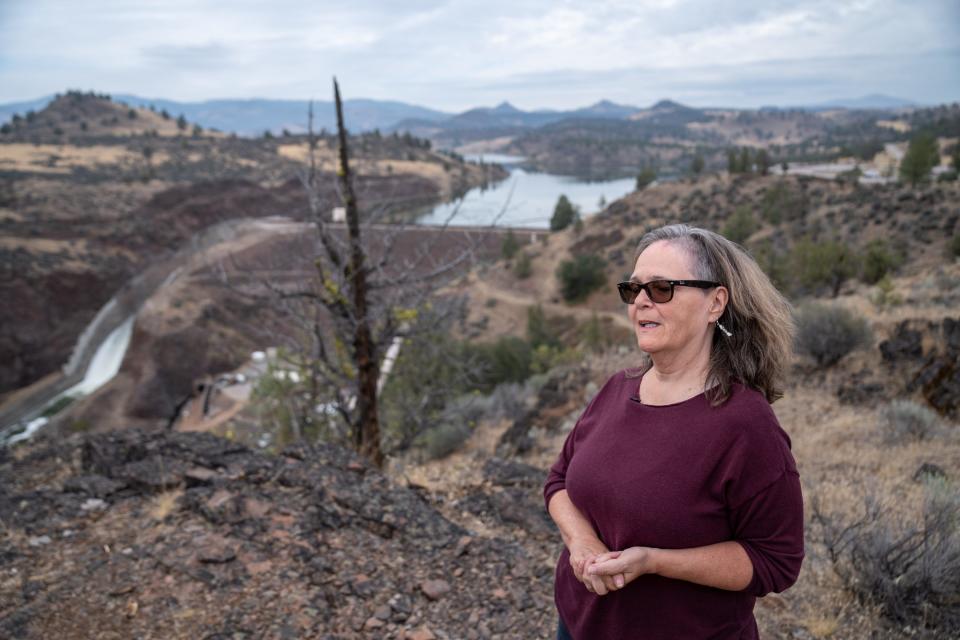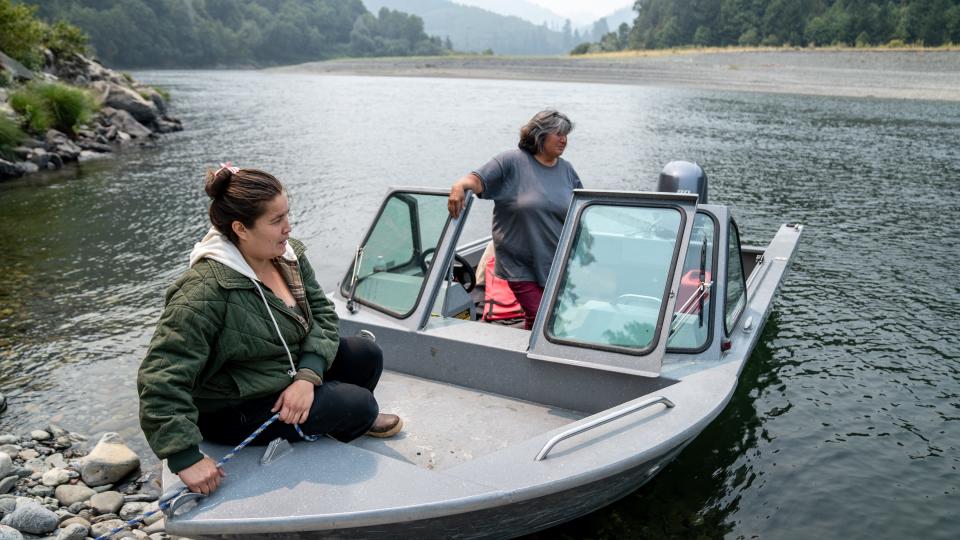Returning to the river: Tribal nations see hope for homelands as Klamath River dams are removed

Restoring a River:
River in recovery| Water shortages| Returning to the Klamath| Restoration begins | Salmon revival
HORNBROOK, Calif. — Jenny Creek burbled cool and clear under a leafy canopy, and dragonflies flitted about the lively little waterway.
But a few hundred feet away, the dreamy little creek drains into Iron Gate Reservoir and an ecological nightmare. Scummy algae-topped water exudes a putrid odor that causes some visitors to gag. At certain times of the year, it's not safe to fish or jump in the reservoir.
Iron Gate and three other shallow, warm-water reservoirs were contributing factors in the disastrous decline of salmon from the Klamath River. The dams cut off nearly 400 miles of spawning habitat for salmon, lamprey, steelhead and other fish from the lower Klamath River, and the toxin-laden warm water flowing down the river caused a horrific fish kill in 2002.
For people who lived along the river, the solution seemed obvious: Take down the dams. And now, after years of legal wrangling, the failure of the Klamath Basin Restoration Agreement, shuffling the dams to several owners and finally, signoff from the Federal Energy Regulatory Commission in November 2022, the nation’s largest dam removal project has commenced.
Other sources of generating electricity have replaced the dams and, by the time they were officially cleared for removal, they were producing just 2% of owner PacifiCorp's portfolio.
"Those dams are obsolete," said Yurok fish protector Georgianna Gensaw.
PacifiCorp was given a choice to install fish ladders instead, but it was the utility's choice to take the dams down, a cheaper option.
The nonprofit Klamath River Renewal Corp. is managing the huge task of moving more than 100,000 cubic yards of concrete, 1.3 million cubic yards of excavated soil and 2,000 tons of demolished steel out of the river channel. Both Native and non-Native construction firms are involved in deconstructing the dams.
Copco No. 2, the smallest of the four, was removed over summer 2023. The Klamath renewal corporation is currently dismantling Copco No. 1, and will watch for the best time during winter 2024 to start drawing the water down. The entire removal project is due to be complete by fall 2024.
Mark Bransom, head of Klamath River Renewal, said the project aims to restore resiliency and balance to the river.
"I think that there's a future, if people will take a little bit longer view of things so they can see the restoration of that balance," he said.
Former Yurok Chairwoman Susan Masten said she never believed she would see the dams come down.
“While I’m ecstatic to witness it, I’m sad that so many people who spent their lives protecting the fish and the river won’t be able to see the Klamath begin to heal itself,” she said.
Even partial recovery of salmon and other fish would provide recreation and community benefits, Bransom said. Also, he said, after the dams are removed, local economies will look different, but can support many communities, ways of life and world views.
"There's a sign in Happy Camp that says, 'Happy Camp, Steelhead Capital of the World,'" Bransom said. He hopes Happy Camp will regain that status as both salmon and steelhead runs are restored after the dams are gone.

Hand collecting billions of seeds and telling the story of restoration
Before the first chunk of concrete was chipped from a dam, crews prepared for land restoration.
"We've been working in the reservoir areas for five years now," said Barry McCovey, director of the Yurok Fisheries Department.
Removing the dams will expose bare hillsides, which workers will revegetate. Tribal members collected seeds from native plants by hand in the area and sent them to seed farms and specialized nurseries in the Northwest, where they eventually grew to hundreds of thousands of plants, trees and shrubs, ready to be planted or spread when each dam removal is complete.
Dave Meurer, director of community affairs for Resource Environmental Solutions, the firm that's overseeing the land restoration, said oak trees about as tall as his knee, plants, plugs and seeds from 98 local species are ready to help repopulate the barren land.
The process was fascinating, Meurer said. "We're now up to somewhere around 17 to 19 billion native seeds that are ready to go on the ground," he said. "When the reservoirs get drained down, it will be the pedal to the metal."
One of Meurer's biggest tasks is planting and nurturing good information to crowd out misinformation "weeds." He said he does a lot of weeding.
"I was just at a meeting with Copco residents and someone had heard from someone else that we will be replanting native plants. 'Well, are you going to be planting foxtails and poison oak?'"
That, Meurer said, was a definite "no." McCovey said plant crews were removing invasive and noxious plants.
"But I think that in the absence of information, there is speculation and rumor and that can really alarm people," said Meurer, who added that his job is to disseminate accurate information to stakeholders and the public to make the restoration process less frightening.

The Shasta Indian Nation makes its bid to regain lands

While the Klamath River dam removal corporation and the ecological restoration firm continue their work, the Indigenous community whose ancestral home was drowned under the rising waters in the 1900s is trying to regain its land.
For millennia, or since time immemorial, the Shasta people have inhabited the region from Seiad Valley east, surrounded by the Klamath, Scott and Shasta rivers and northeast to Jenny Creek and into southern Oregon.
But portions of the lands soon to be reclaimed after the dams are gone are the ancestral home of the Kikacéki and Kutarawaxu bands of Shasta, who today are known as the Shasta Indian Nation. And they want at least some of that land back.
Kikacéki land encompasses K’účasčas, a place sacred to tribal members around the mouth of Fall Creek along with what's now known as Ward's Canyon, said Sami Jo Difuntorum, cultural preservation officer for the nation.
"Within the traditional river channel are traditional fishing sites where we traditionally dipped-net fished for time immemorial, as they say," she said.

Unratified treaties, genocidal attacks, eminent domain seizures
The coming of the Americans threw the Shasta peoples and other Indigenous peoples of California into a time of terror, chaos, mass murder and land losses.
Several bands of Shastas, known as "Upper Klamath" of the Shasta and Scott rivers, signed onto the third of 18 treaties negotiated with California tribes with agent Redick McKee in November 1851.
In return for ceding all "right, title, claim or interest of any kind which they or either of them have to the lands they now occupy, and to all other lands or soil in California" to the U.S., they would receive reservation lands.
The U.S. Senate never ratified that or the other 17 treaties, instead locking them away in secret for decades. The Shastas, along with several hundred other California tribes, were left to their own devices to defend themselves against an ever-growing incursion of gold miners, farmers, loggers and other settlers determined to take land for themselves.

Tribes up and down the Klamath endured many atrocities. In one 1854 incident, a small family band led by Chief Bill holed up in a cave in the Kikacéki district where Army troops and vigilantes attacked them with a howitzer to force them out over an alleged attack of a settler. The first assault on the cave hideout killed three Shasta men, two women and three children.
The Army representative felt the miners were to blame for the unprovoked attack on the Shasta people with the goal of kidnapping women. But the vigilantes still managed to get Bill, killing him two weeks later.
Brian Daniels, director of research and programs for the Penn Cultural Heritage Center at the University of Pennsylvania Museum, said every member of the Shasta Indian Nation today had an ancestor hiding in the cave. Daniels said the Shastas worked to rebuild their community in the wake of the genocide.
Under the leadership of Shasta leader Bogus Tom Smith, the Shastas began to acquire land to recreate their homeland. Bogus Tom arranged marriages between Shasta women and white or non-Indian landowning families. They obtained allotments through the Dawes Act. And sometimes, Daniels said, they squatted on newly privatized land.
The land submerged behind Copco I Dam is all Shasta land, said Daniels and Difuntorum. They pointed out Kitty Ward's ranch, the Keaton homestead and Difuntorum's great-aunt Lucy Raymond's ranch, all reacquired to ensure their tribe would have a home. Ancient villages also lie beneath the waters, waiting to reemerge.
Change: New Tribal Water Institute will help Arizona tribes navigate water law and policies
"This is this space that this entire community is trying to hold together and keep together," said Daniels, who has worked with the Shastas for several years on anthropological and historical research.
But those lands would soon be wrested from the hands of Bogus Tom's descendants. The state used eminent domain to seize the community the Shastas had worked to rebuild for the first of the dams in the early 1900s.
Difuntorum burst into tears as Daniels described Kitty's refusal to be removed from her land. "I no move, water come, I die here,” Ward was reported to have said. Ward died of a cerebral hemorrhage after she was lured to leave her home only to be barred from returning. "All this happened just 100 years ago," Difuntorum said.
That lack of a land base also meant the Kikacéki and Kutarawaxu Shasta peoples were not included on the rolls of federally recognized Indian tribes established in 1934 through the Indian Reorganization Act, while other Shasta bands were recognized, some in Scott Valley and others who were incorporated into tribal confederations in Oregon.
Lacking federal recognition means that the Shasta Indian Nation isn't eligible for a multitude of programs and protections, including health care, education and housing. Although the federal law mandating the return of Indigenous remains and funerary objects only covers federally recognized tribes, California has some stronger protections for all Indigenous California tribes' ancestors and culturally important items.
But reclaiming ancestral remains and cultural items is still a process fraught with grief and frustration to not only the Shastas but the rest of all California tribes — one third in all — not on the government's list of recognized tribes.

Hope to reclaim Kikacéki rises as dams and reservoirs fall
With the dam removal underway, the Shasta Nation has requested the return of about 2,000 acres of what's known as "Parcel B" lands. It's land previously owned by PacifiCorp that under the dam removal agreement will be transferred to the states of California and Oregon or a designee by the state to be managed for public interest purposes.
Difuntorum said the nation was assessing an empty building left behind in the wake of PacifiCorp's departure to use as a cultural and visitor center. She said The Republic was among the first to learn of the tribe's plans, which Difuntorum said would likely lead to opposition.
The Shastas know that to restore and regain their land, more damage may occur. Difuntorum said being on site when burials are disturbed or cultural resources damaged can be painful.

Shasta Tribal Councilmember Michael Olson, who serves as a cultural monitor when construction crews operate in known village or burial sites, said it's certain more damage would occur.
"Everybody wants a healthy river and healthy fish," Difuntorum said.
But the 300 members of the Shasta Indian Nation want more than their fish restored; they also want to return home. Difuntorum said when Shasta Nation members, most of whom still live in Siskiyou County, heard the tribal council planned to ask for a portion of their homeland to be returned, they were already putting in for homes.
Difuntorum, an experienced community planner, was already assessing homesites, water and wastewater availability.
And even more important: "We want ceremony back," she said. Native religions are land-based and the Shastas want to restore their religion, so Kikacéki, their most significant land, deserves to return to Shasta hands as it emerges from its watery grave, Difuntorum said.
"I look at my little grandsons and I believe they deserve to have culture, have ceremony and to have tradition."
Debra Krol reports on Indigenous communities at the confluence of climate, culture and commerce in Arizona and the Intermountain West. Reach Krol at debra.krol@azcentral.com. Follow her on X, formerly Twitter @debkrol.
Coverage of Indigenous issues at the intersection of climate, culture and commerce is supported by the Catena Foundation.
My articles are free to read, but your subscriptions support more such great reporting. Please consider subscribing today.
Next up:
On the lower Klamath River, tribes guard the water, land
Debra Utacia Krol
Arizona Republic
REQUA, Calif. - Queen Gensaw skylarked around and between her parents, Oscar and Georgianna, at the Yurok Tribe's boat ramp at Requa, or Rek-woi, the “mouth of the creek” where the Klamath River meets the Pacific Ocean.
Here, millennia of flowing water infused with sand, silt and the occasional river-smoothed rock has created a cleft about 125 feet deep by nearly 1,000 feet wide. Queen, who is 7, examined shells and danced around the asphalt as her parents talked nearby. For the Yurok fighting to restore the river and secure one of their cultural touchstones — the salmon — Queen and her friends are the future.
This article originally appeared on Arizona Republic: Klamath River dam removal could open lands for tribal nations


